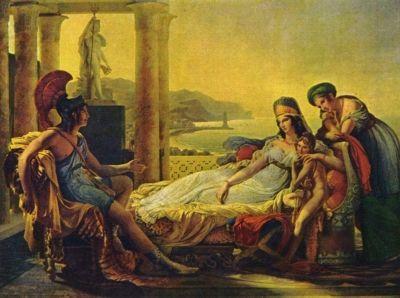
Written by Henry Purcell during the early parts of the Baroque period. Dido and Aeneas is a tragic love story about early greek mythological characters. Musically, the songs are very simple. The theory behind them is very basic and easy to see, so the piece shouldn't prove difficult to analys.
The Overture
This polyphonic opening to the piece starts out using the tonic (Cm) and progresses mostly with half and imperfect authentic cadences (Fm and Gm). Built up using two parts A and B. The A section is repeated twice, and leads into the B part. Part A has a melodic theme of using chromatics. This use of chromatics makes the chords sound like they are under stress; with this and the fact that the song is written in Cm and played at an adagio, the song sounds sad and confused at the beginning.
After the repeat, part B is stated with a new melody. This is designed mostly like a fugue. The first violin starts the melody in the tonic key, then the second violin answers with the same melody but starting on the dominant, then the viola enters with the supertonic. This is basically dropping v's (minor fifths) form the last played chord, and was a very popular pattern in baroque fugues. The same thing can be seen in J.S. Bach's Little Fugue where the same idea is used to answer each previously stated chord in the melody. This pattern continues as the melody lines change in each voice and eventually end the piece with a strong perfect authentic cadence.

|
Dido and Aeneas - Overture.mp3 Size : 1.409 Kb Type : mp3 |
(I'm skipping to the Lament for right now)
Dido's Lament No. 36 RECIT. - No. 37 RECIT.
With all trageties, a moment of defeat and/or sadness is needed. In Dido and Aeneas this moment comes with Aeneas' rejection of Dido, and heart broken she decideds that there is no point in her life continuing. She felt that it was her fate to be with Aeneas, and now that that is no longer possible, what more out of life should she possible hold out for in order to see through? So this piece is about her saying good-bye to Belinda. A nine measure opening to the lament is written in with a tonic Cm, and is written only as an intro. Basically, Dido says that she has chosen to die, and musically the violins and harpsichord set up a slow moving background. The chords being played match well by moving between i, V7, iv, iv6(deminished). This feels predicable to the listener since they fit will together, and with the slow moving backgrounds, this sets a kind of fated or impending feeling. After the small intro, the key shifts to the dominate after a half cadence, and continues from now on as a aria. The same drulling backgrounds continue with a new chord set; Gm, D7, Dm, C, Cm, D7, Gm, A7(half deminished), Gm, D7. The sad tone is created with the use of minor chords, since half the chords used in the main repeated section over the vocals in half minor, this adds sadness to Dido's words. A playing speed of larghetto makes the notes sing out more, which with the effect of the minor chords adds a lingereing sadness as the song unfolds. Chromatics are used aswell, which adds more distilled feelings as they force the chords to make odd changes. Each new five measure phrase is set up with an authentic cadence, which creates a nice sound. This is probably to make Dido sound at peace with her decision to end her life. Viberally, Dido asks that she be remembered, and that she wishes no problems for Belinda or anyone who may feel such from her death.
Thought the song is sad, it is still beautiful. It reminds me of sakura blossoms, in how they beautiful and are looked forward too, but they only live for a short amount of time. Dido blossoms and then fades away, and fades away to this song. A person can feel bad, and sorry for Dido without any idea why she has chosen to die. But this death was needed, it was something that was going to happen and was set up as the play evolved. Even in the overture, it ends with a sad chord Cm (i). This sets that the ending of the piece will be sad, and so the ear was expecting this to happen and is cued in as the end with the No. 36 RECIT. which is in the same key as the overture. The movement in the piece if wonderful, and leaves a lasting impression far after the short song is over.
The file doens't have the 9 measure Cm intro on it.

|
Dido's Lament.mp3 Size : 1.765 Kb Type : mp3 |